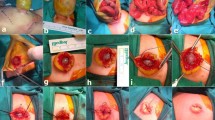Abstract
Several embryopathies involve umbilicus including midgut herniation, omphaloceles, urachal and vascular anomalies. Although described earlier, hernia into umbilical cord has not found enough mention in the literature. Poor understanding of its clinical characteristics has made to miscategorization of this entity as “omphalocele minor” by many. Some of these undergo spontaneous reduction or epithelialisation if left alone. The present study describes a series of four consecutive cases of this entity and describe their clinical characteristics, associated GI anomalies and possible embryogenesis.
Similar content being viewed by others
References
Pal K, Nofal A. Umbilical henia associated with extracelomic intestinal atresia and perforation of the ileum in a newborn. Ann Saudi Med 2007;27:212–213.
Burns C W, Ogrylo MA. Congenital Hernia into the Umbilical cord; two cases, one associated with persistent cloaca. Can Med Assoc J 1938;39:438–441.
Hempel-Jorgensen P. Familial congenital umbilical hernia. Ugesk f Laeger 1929;91:273–274.
Tow. Diseases of the Newborn NewYork; Oxford Medical Publication, 1937, 224–226.
Jona JZ. Congenital hernia of the cord and associated Omphalomesenteric duct:a frequent neonatal problem. Am J Perinatol 1996;13:223–226.
Achiron R, Soriano D, Lipitz S, Mashiach S, Goldman B, Seidman DS. Fetal midgut herniation into the umbilical cord: improved definition of ventral abdominal anomaly with the use of transvaginal sonography. Ultrasound Obstet Gynecol 1995;6:256–260.
Louw JH, Barnard CN. Congenital atresia: observations on its origin. Lancet 1955;2:1065–1067.
Abrams JS. Experimental intestinal atresia. Surgery 1968;64:185–189.
Santulli TV, Blanc WA. Congenital atresia of the intestine: pathogenesis and treatment. Ann Surg 1961;154:939–942.
Nixon HH, Towes R. Etiology and treatment of small intestinal atresia: analysis of a series of 127 jejunoileal atresias and comparision with 62 duodenal atresias Surgery 1971;69:41–45.
Okmian LG, Kovamees A. Jejunal atresia with intestinal aplasia: strangulation of the intestine in the extraembryonic celom of the belly stalk. Acta Pediatr Scand 1964;53:65–68.
Author information
Authors and Affiliations
Corresponding author
Rights and permissions
About this article
Cite this article
Pal, K., Ashri, H. & Al Wabari, A. Congenital hernia of the cord. Indian J Pediatr 76, 319–321 (2009). https://doi.org/10.1007/s12098-009-0061-x
Received:
Accepted:
Published:
Issue Date:
DOI: https://doi.org/10.1007/s12098-009-0061-x




